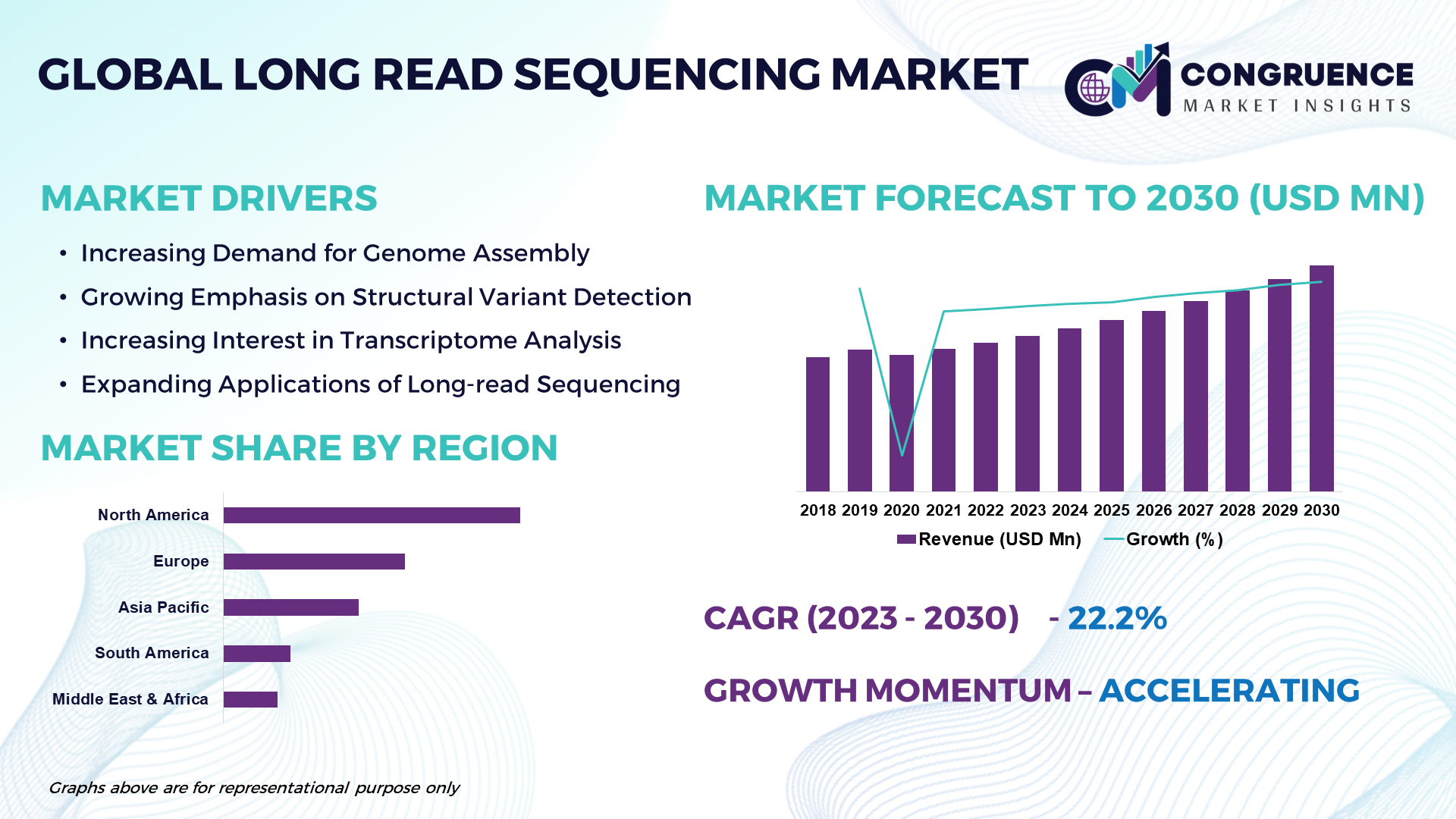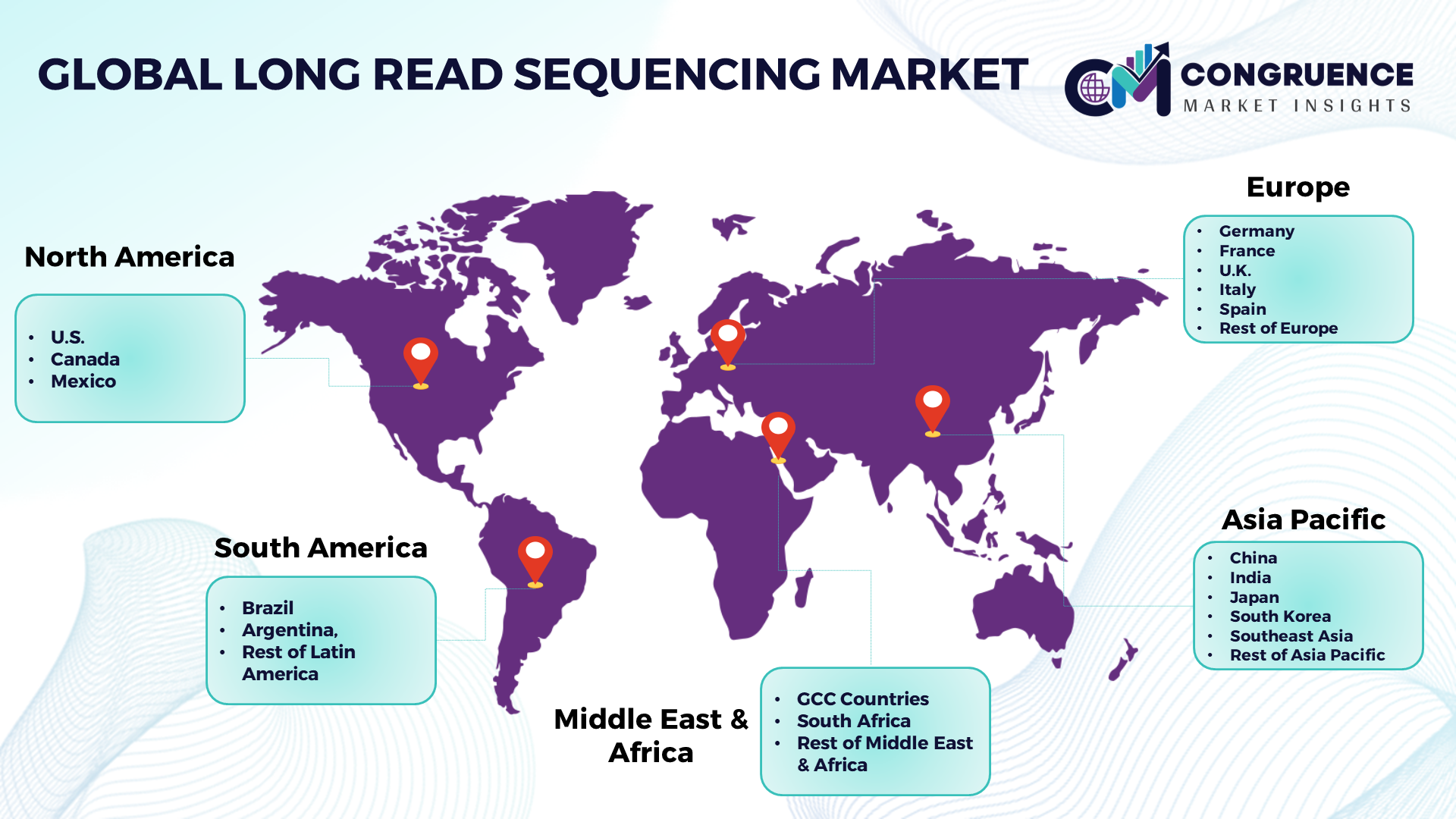Reports
The Global Long Read Sequencing Market is projected to expand at a remarkable CAGR of 22.2% from 2023 to 2030, driven by factors such as technological advancements in long-read sequencing platforms, the rising prevalence of genetic diseases, and the increasing adoption of personalized medicine approaches. Long read sequencing, also known as third-generation sequencing, is an advanced genomic technology that enables the sequencing of long DNA fragments, providing comprehensive insights into complex genomes, structural variations, transcriptomes, and epigenetic modifications. This technology offers several advantages over short-read sequencing methods, including the ability to sequence long DNA fragments without assembly, detect complex genomic rearrangements, and analyze full-length RNA transcripts. The Long Read Sequencing Market is experiencing rapid growth driven by the increasing demand for high-resolution genomic analysis, the growing adoption of long-read sequencing technologies, and the need for comprehensive genome characterization in research, clinical diagnostics, and precision medicine applications. Long read sequencing is revolutionizing genomics research and biomedical science by enabling the accurate identification of structural variations, transcript isoforms, and epigenetic modifications that play critical roles in disease pathogenesis, drug response, and personalized medicine.

Long Read Sequencing Market Major Driving Forces
Genome Assembly: The increasing demand for efficient and accurate genome assembly methods, de novo sequencing approaches, and reference-free genome mapping techniques is driving the adoption of long-read sequencing technologies for genome assembly, contig scaffolding, and genomic structural annotation in genomics research, molecular biology, and bioinformatics.
Structural Variant Detection: The growing emphasis on structural variant detection, complex genomic rearrangements, and chromosomal abnormalities in disease research, cancer genomics, and population genetics studies is driving the demand for long-read sequencing technologies for structural variant analysis, copy number variation detection, and chromosomal rearrangement profiling in human genetics and molecular pathology.
Transcriptome Analysis: The increasing interest in transcriptome analysis, alternative splicing, and isoform diversity in gene expression regulation, developmental biology, and precision oncology is driving the adoption of long-read sequencing technologies for full-length RNA sequencing, transcript isoform characterization, and gene expression profiling in transcriptomics research and molecular medicine.
Epigenetic Analysis: The growing importance of epigenetic analysis, DNA methylation profiling, and chromatin modification studies in gene regulation, cellular differentiation, and disease pathogenesis is driving the demand for long-read sequencing technologies for epigenomic analysis, DNA methylation detection, and histone modification profiling in epigenetics research and molecular genetics.
Research and Clinical Applications: The expanding applications of long-read sequencing in basic research, translational medicine, clinical diagnostics, and pharmaceutical development for genomic research, precision medicine, and drug discovery present opportunities for research institutes, biotechnology companies, and pharmaceutical firms to leverage long-read sequencing technologies for comprehensive genomic analysis and personalized medicine approaches.
Long Read Sequencing Market Key Opportunities
Clinical Diagnostics: The increasing adoption of long-read sequencing technologies in clinical diagnostics, genetic testing, and molecular pathology for disease diagnosis, patient stratification, and therapeutic decision-making presents opportunities for diagnostic laboratories, healthcare providers, and molecular diagnostic companies to offer comprehensive genomic testing services and personalized medicine approaches for genetic diseases, cancer genomics, and rare disorders.
Precision Medicine: The growing emphasis on precision medicine, personalized genomics, and targeted therapies based on individual genomic profiles, genetic variations, and disease signatures presents opportunities for pharmaceutical companies, biotechnology firms, and healthcare providers to leverage long-read sequencing technologies for patient stratification, treatment selection, and therapeutic development in precision oncology, rare diseases, and inherited disorders.
Genomic Research: The expanding applications of long-read sequencing technologies in genomic research, functional genomics, and systems biology for genome-wide association studies, genomic epidemiology, and functional annotation of genetic variants present opportunities for academic research institutions, biotechnology laboratories, and genomic research centers to explore new avenues in genomics, transcriptomics, and epigenomics research using high-resolution long-read sequencing techniques.
Clinical Trials: The integration of long-read sequencing technologies into clinical trials, pharmacogenomics studies, and drug discovery programs for patient stratification, biomarker identification, and drug response prediction presents opportunities for pharmaceutical companies, contract research organizations (CROs), and clinical research institutions to enhance clinical trial efficiency, improve patient outcomes, and accelerate drug development timelines using genomic profiling and molecular diagnostics.
Population Genomics: The application of long-read sequencing technologies in population genomics, evolutionary genetics, and comparative genomics for species diversity analysis, population structure inference, and genetic adaptation studies presents opportunities for biodiversity research, conservation biology, and ecological genomics to understand the genetic basis of species evolution, ecological adaptation, and environmental interactions using high-throughput long-read sequencing platforms.
Long Read Sequencing Market Key Trends
· Single-Molecule Real-Time Sequencing: The growing adoption of single-molecule real-time (SMRT) sequencing technologies, third-generation sequencing platforms, and high-fidelity polymerase enzymes for long-read sequencing applications, full-length RNA sequencing, and epigenetic analysis in genomics research, molecular diagnostics, and personalized medicine.
· Nanopore Sequencing: The development of nanopore sequencing technologies, portable sequencing devices, and single-molecule nanopore sensors for long-read DNA sequencing, real-time genome analysis, and point-of-care diagnostics in field-based research, clinical diagnostics, and environmental monitoring applications.
· Genome Assembly: The advancement of long-read sequencing technologies for de novo genome assembly, contig scaffolding, and reference-free genome mapping using long DNA fragments, optical mapping techniques, and high-resolution imaging systems for comprehensive genome characterization and genomic structural annotation.
· Structural Variant Detection: The implementation of long-read sequencing technologies for structural variant detection, complex genomic rearrangement analysis, and chromosomal rearrangement profiling in cancer genomics, human genetics, and molecular pathology for accurate identification of disease-causing mutations and chromosomal abnormalities.
· Transcriptome Analysis: The integration of long-read sequencing technologies into transcriptome analysis, full-length RNA sequencing, and isoform-specific gene expression profiling for transcriptomics research, alternative splicing analysis, and gene expression regulation studies in developmental biology, cell biology, and precision medicine.

Market Competition Landscape
The global long read sequencing market is characterized by a competitive landscape with a mix of established biotechnology companies, genomic technology providers, and molecular diagnostics firms offering a wide range of long-read sequencing platforms, single-molecule sequencing technologies, and bioinformatics solutions for genomic analysis, clinical diagnostics, and precision medicine applications. Prominent players in the long read sequencing market include:
· Pacific Biosciences of California, Inc.
· Oxford Nanopore Technologies Ltd.
· 10x Genomics, Inc.
· Bionano Genomics, Inc.
· Dovetail Genomics, LLC
· Phase Genomics, Inc.
· Nabsys, Inc.
· Cytoscan Technologies Inc.
· NuGEN Technologies, Inc.
· InPhase Biosciences Inc.
These companies offer single-molecule real-time (SMRT) sequencing platforms, nanopore sequencing devices, long-read sequencing kits, and bioinformatics solutions for genomic research, clinical diagnostics, and precision medicine applications.
|
Report Attribute/Metric |
Details |
|
Base Year |
2022 |
|
Forecast Period |
2023 – 2030 |
|
Historical Data |
2018 to 2022 |
|
Forecast Unit |
Value (US$ Mn) |
|
Key Report Deliverable |
Revenue Forecast, Growth Trends, Market Dynamics, Segmental Overview, Regional and Country-wise Analysis, Competition Landscape |
|
Segments Covered |
· By Technology (Single-Molecule Real-Time Sequencing, Nanopore Sequencing) · By Application (Genome Assembly, Structural Variant Detection, Transcriptome Analysis, Epigenetic Analysis) · By End-user (Research Institutes, Biotechnology Companies, Pharmaceutical Companies) |
|
Geographies Covered |
North America: U.S., Canada and Mexico Europe: Germany, France, U.K., Italy, Spain, and Rest of Europe Asia Pacific: China, India, Japan, South Korea, Southeast Asia, and Rest of Asia Pacific South America: Brazil, Argentina, and Rest of Latin America Middle East & Africa: GCC Countries, South Africa, and Rest of Middle East & Africa |
|
Key Players Analyzed |
Pacific Biosciences of California, Inc., Oxford Nanopore Technologies Ltd., 10x Genomics, Inc., Bionano Genomics, Inc., Dovetail Genomics, LLC, Phase Genomics, Inc., Nabsys, Inc., Cytoscan Technologies Inc., NuGEN Technologies, Inc., and InPhase Biosciences Inc. |
|
Customization & Pricing |
Available on Request (10% Customization is Free) |
